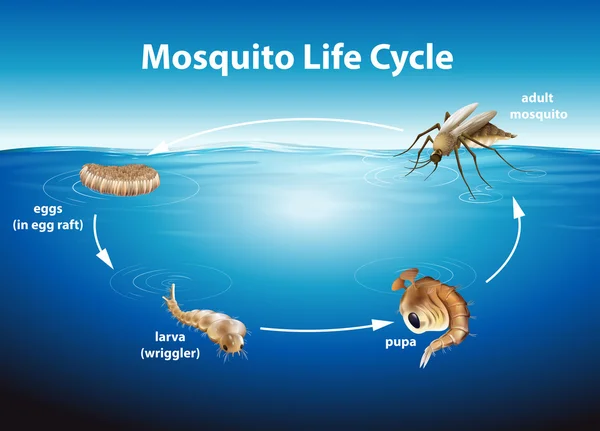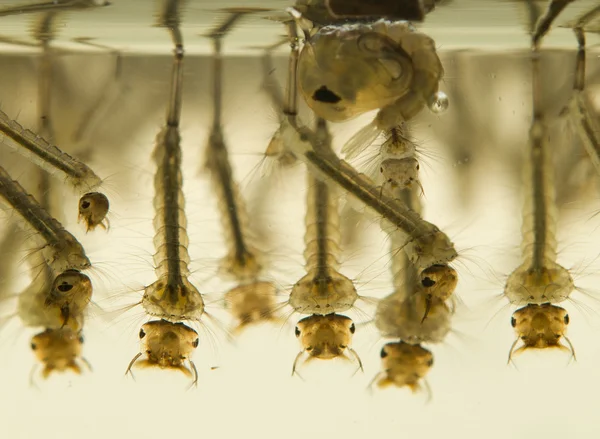Are you wondering about the variety of foods your goldfish can eat? Have you ever wondered do goldfish eat mosquito larvae?
The ability to consume almost everything has made the goldfish a highly coveted fish by aquarium lovers. Thus, goldfish do consider mosquito larvae edible and can eat them. Mosquito larvae are a good food source for your goldfish, and your fish will heartily consume them.
Mosquito larvae are full of nutritional richness, making it a good meal for your goldfish, and it can be served either frozen, live, or freeze-dried.
In this article, I will detail all you need to know about your goldfish and how they can eat mosquito larvae and some precautions.
What Are Mosquito Larvae?

A typical mosquito undergoes four life cycles, with larvae being the second phase of the cycle. Although the first three stages are technically aquatic, the goldfish is likely to eat mosquitos in any of their life stages.
However, the easiest stage for your fish to make a meal of them is when they are in the larva stage.
Larvae exist in various colors and are usually sold in black, white, and red (commonly referred to as bloodworms). To your goldfish, they are all the same.
This meal is typically a significant food source in the wild. All omnivorous fish will naturally eat them as long as they are large enough.
What Benefits Are Derivable When Fish Eat Mosquito Larvae?
Larvae have many nutrients that make them the perfect meal for your goldfish. They provide a balanced diet that will make your goldfish grow rapidly while staying healthy.
You can feed mosquito larvae to your goldfish when they are being picky and avoiding their usual goldfish food; they will devour them.
It is often challenging to provide your goldfish solely with mosquito larvae. However, they are a rich meal that helps your fish meet its dietary needs. You can feed your fish other insects and get similar benefits too.
However, it’s not ideal to focus on feeding your fish solely with larvae, as the fish might increase in body weight and become ill due to a low intake of other meals that provide other needed nutrients in their diet.
What Forms Are Mosquito Larvae Available In?
Mosquito larvae can be fed to both larger fish and small goldfish in two ways, either live or frozen, each with pros and cons. Below is a review of these forms.
Living Larvae
Live mosquito larvae can be purchased from pet stores in bags. Live larvae wiggle constantly, so you can be sure that they are alive before buying them (dead larvae have little nutritional value).
Upon arriving home with your purchase, pour the bag’s content into a strainer and rinse the larvae of unclean water. It’s then ready for your goldfish!
Once the goldfish sees the wiggly larvae in the aquarium, it will be attracted to them and will often consume them within minutes.
Larvae not consumed at first might live for a couple of days before getting eaten.
Advantages and Disadvantages of Live Mosquito Larvae
A significant advantage of giving your fish live mosquito larvae is that they can live in the tank for a while even if not eaten, unlike dry larvae that will rot and contaminate the tank if not eaten.
A disadvantage of live mosquito larvae is that they can’t be kept for long, meaning you have to make your purchase when you intend to feed the larvae to your fish.
Another disadvantage is the possibility of live mosquitoes bringing disease to your fish water, though this is an infrequent occurrence.
Fish that eat mosquitoes will also eat mosquito larvae, and they can reduce the mosquito population and help with mosquito control. Eating larvae is not restricted to goldfish types, as other tropical fish also consume mosquito larvae. Guppies, for example, eat mosquito larvae.
Frozen Mosquito Larvae
When you visit stores to buy frozen mosquito larvae, they are often sold in packs or other broken-down sizes, depending on the quantity you want to purchase.
In the process of giving these frozen larvae to your fish, you can either put the cube in the tank (or pond water) and allow your goldfish to nibble at it as it defrosts, or you can place the cube in a bowl of aquarium water and let it defrost before pouring it to the main tank.
Advantages and Disadvantages of Frozen Mosquito Larvae
Unlike live larvae that need to be purchased on-demand, you can keep a pack or two in the freezer for a long time (months or possibly years) and only cut out slabs that you intend to feed to your goldfish when required.
The main disadvantage of frozen mosquito larvae is that it is often impossible to tell if you have purchased a quality larvae pack or not. Were they dead, or were they a wiggly soup of larvae? Only purchase your frozen tiny mosquito larvae from reputable stores to ensure that you buy top-quality food for your goldfish.
How Constantly Should Your Goldfish Be Fed Larvae?
Mosquito larvae are a rich source of protein, fat, and fiber, but they should not be fed to your goldfish for every meal.

For instance, if you feed your goldfish 3 or 4 times daily, one of the meals can be mosquito larvae, bloodworms, or alternative goldfish foods.
Other Live Food to Feed Your Goldfish
Your fish will gladly eat any of the following other frozen foods:
- Daphnia
- Bloodworms
- Brine Shrimp
- Mysis shrimp
- and other live small crustaceans
Is It Possible to Make Your Own Mosquito Larvae?
There’s an important caveat when trying to produce mosquito larva at home, as they are often a cause of ailments in many countries. Hence, take special care when attempting to produce at home.
You can make your own bowl of mosquito larvae yourself; all you need is to put a container of shallow water outside in the spring or summer months.

Inadvertently, female mosquitoes will be attracted to the water and gladly litter it with their eggs. Mosquitoes are aquatic pests and thrive in adequate water temperatures, regardless of hot or cold conditions.
Once you notice the wiggly little creatures in the water, you can easily fish them out and pour them into your fish tank for your fish, who will eat them alongside other foods in their daily intake.
Smaller fish are known to eat mosquitoes just like the larger fish, as eating mosquitoes are common to most fish types.
Conclusion
Like other live food for your goldfish, larvae are another essential source of protein, fiber, and fat to your fish and can be fed sparingly. They are an excellent supplement to other foods.
Use mosquito larvae as part of your goldfish’s varied, balanced diet and feed them as a treat now and then. Eating mosquito larvae is not restricted to a single fish species, as other species will eat larvae comfortably too.
Related Reading:

